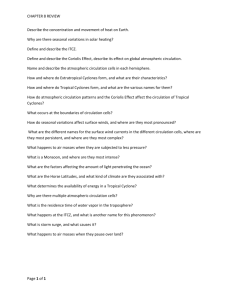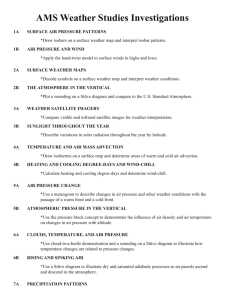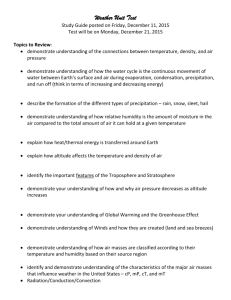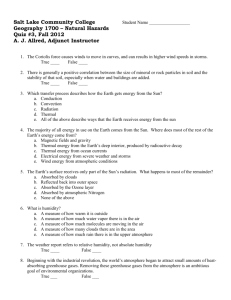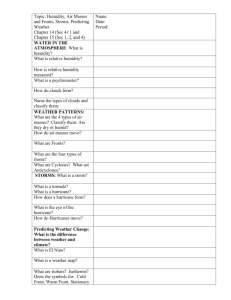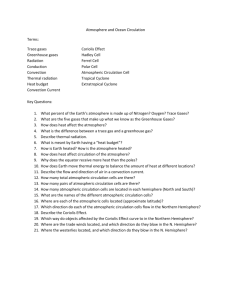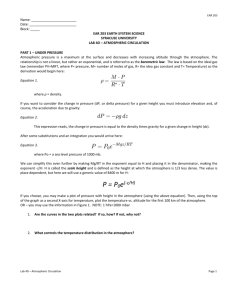Class 8: Global Temperature Patterns, Ocean
advertisement
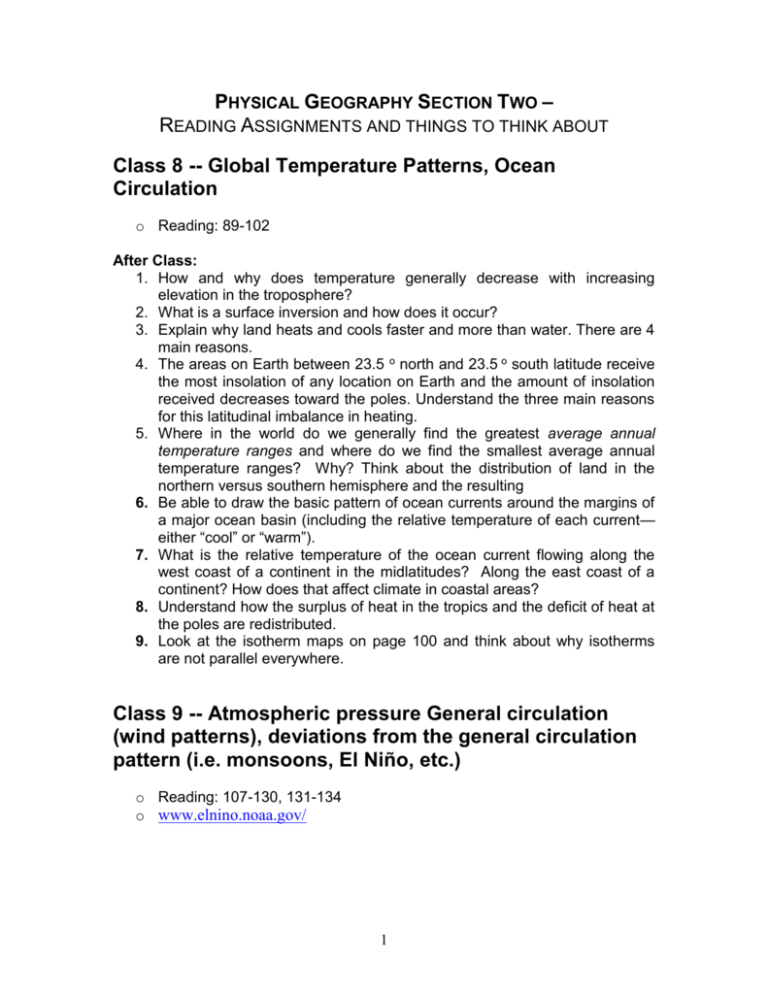
PHYSICAL GEOGRAPHY SECTION TWO – READING ASSIGNMENTS AND THINGS TO THINK ABOUT Class 8 -- Global Temperature Patterns, Ocean Circulation o Reading: 89-102 After Class: 1. How and why does temperature generally decrease with increasing elevation in the troposphere? 2. What is a surface inversion and how does it occur? 3. Explain why land heats and cools faster and more than water. There are 4 main reasons. 4. The areas on Earth between 23.5 o north and 23.5 o south latitude receive the most insolation of any location on Earth and the amount of insolation received decreases toward the poles. Understand the three main reasons for this latitudinal imbalance in heating. 5. Where in the world do we generally find the greatest average annual temperature ranges and where do we find the smallest average annual temperature ranges? Why? Think about the distribution of land in the northern versus southern hemisphere and the resulting 6. Be able to draw the basic pattern of ocean currents around the margins of a major ocean basin (including the relative temperature of each current— either “cool” or “warm”). 7. What is the relative temperature of the ocean current flowing along the west coast of a continent in the midlatitudes? Along the east coast of a continent? How does that affect climate in coastal areas? 8. Understand how the surplus of heat in the tropics and the deficit of heat at the poles are redistributed. 9. Look at the isotherm maps on page 100 and think about why isotherms are not parallel everywhere. Class 9 -- Atmospheric pressure General circulation (wind patterns), deviations from the general circulation pattern (i.e. monsoons, El Niño, etc.) o Reading: 107-130, 131-134 o www.elnino.noaa.gov/ 1 Before Class: 1. What is atmospheric pressure? What does it mean that it is omnidirectional? 2. Know how atmospheric pressure changes with increasing altitude. 3. Explain how atmospheric pressure is related to air density and air temperature. 4. What factors cause high atmospheric pressure or low atmospheric pressure near the surface? 5. Understand that air moves from areas of high pressure to low pressure. 6. Know that high atmospheric pressure is usually associated with descending (or sinking) air and low atmospheric pressure with ascending (or rising) air. After Class: 1. Draw and label cyclonic and anticyclonic circulation patterns in both the upper and lower atmosphere in the Northern Hemisphere. You should have four different patterns of circulation. 2. Describe how the pressure gradient influences wind speed. 3. Why are upper air winds faster than surface winds? 4. What are Hadley Cells? Describe the circulation pattern in the Hadley Cells. 5. Be able to draw the general circulation pattern of the atmosphere including the major wind systems (trade winds, westerlies, easterlies), pressure systems (subtropical high, subpolar low, ITCZ, polar high), and the latitudes of each. 6. Know how the ITCZ shifts seasonally, what causes the shift, and the effects on weather. 7. Describe the general location and characteristics of the Jet Streams. 8. Explain the processes associated with land and sea breezes. Which are we more likely to experience in the Bay Area during the summer? What about during the winter? 9. Describe how the South Asian Monsoon is influenced by the shifting ITCZ. What do the changing high and low pressure systems mean for weather patterns in the areas affected? 10. How is California weather affected by the shifting of the ITCZ? 11. Contrast the oceanic and atmospheric conditions in the tropical Pacific Ocean during an El Niño events versus “normal” conditions. 12. What are some of the effects of an El Niño event? 2 Class 10 -- Moisture in the Atmosphere o Reading: 141-152 Before Class: 1. Understand the structure of a water molecule including the covalent bonds between the hydrogen and oxygen atoms and the dipolarity of the molecule. Draw a water molecule and label it including charge. 2. What is a hydrogen bond? 3. Understand the unique properties that water has because of hydrogen bonding including: capillarity and surface tension. 4. Know the boiling and freezing points of water. After Class: 1.Be able to describe how much energy is involved in phase changes of water and whether heat is gained or lost during each. 2. How is evaporation a cooling process and condensation a warming process? What does that mean for the temperature of the surrounding air? 3. Define: vapor pressure, absolute humidity, specific humidity, and relative humidity. 4. What determines the water vapor capacity of air? 5. What happens to the relative humidity of a parcel of air when temperature decreases? Increases? Why? (refer to figure 6-11) 6. Be able to calculate the relative humidity of a parcel of air if given the temperature, specific humidity and saturation specific humidity. 7. What is the dew point temperature? 8. Explain the role of condensation nuclei in the condensation process. Class 11 -- Clouds, fog, and precipitation o Reading: 153-172 Before Class: 1. Review adiabatic heating and cooling from Ch. 4. 2. Know the difference between saturated adiabatic rate and dry adiabatic rate. 3. What cooling process is responsible for the formation of most clouds? 4. Describe the four main lifting mechanisms of air. After Class: 1. Why does rising unsaturated air cool more quickly than rising saturated air? 3 2. What is a rain shadow and why does one form? Explain the role of adiabatic temperature changes, changes in water vapor content and relative humidity in the formation of rain shadows. 3. How does the “rain shadow effect” affect climate and the distribution of precipitation in the western U.S.? 4. Describe the 3 main forms (shapes) of clouds. Under what conditions does each form? 5. Describe the ways that fog forms. 6. What makes air unstable? 7. How can air become unstable after it is forced to rise? 8. What types of clouds are associated with stable versus unstable air? 9. How does precipitation form? 10. Know the difference between: rain, snow, sleet, hail. 11. Study figures 6-35 and 6-36 and understand how precipitation patterns shift annually with the ITCZ. Class 12 -- Weird Weather I – fronts, midlatitude cyclones, midlatitude anticyclones, thunderstorms, hail o Reading: 166-167, 179-192, 200-203 o http://www.erh.noaa.gov/cae/svrwx/hail.htm (hail) o http://www.windows.ucar.edu/tour/link=/earth/Atmosphere/tstorm.html (thunderstorms and thunderstorm formation) Before Class: 1. What is an air mass and what conditions are necessary for one to form? Where are air masses likely or unlikely to form? What are good source regions for air mass formation? 2. What is the difference between a cold front and a warm front? After Class: 1. Under what conditions does hail form? In what parts of the country is hail most likely to occur? 2. Describe the differences in the movement of cold fronts versus warm fronts. 3. Describe the pressure and wind patterns associated with a midlatitude cyclone. 4. Be able to describe how the movement of a midlatitude cyclone will affect weather including: precipitation, wind speed and direction, atmospheric pressure, temperature, and clouds. 5. What is an occluded front and what does it mean for the life expectancy of a midlatitude cyclone? 6. Discuss the sequence of thunderstorm formation and the conditions that favor thunderstorm formation. 4 Class 13 -- Weird Weather II – tornadoes, tropical cyclones (a.k.a. – hurricanes) o Reading: 193-200, 204-207 o http://www.nhc.noaa.gov/ (national hurricane center) o http://ww2010.atmos.uiuc.edu/(Gh)/guides/mtr/hurr/home.rxml (hurricanes) o http://www.nssl.noaa.gov/edu/safety/tornadoguide.html (tornadoes) Before Class: 1. What kind of pressure system is a hurricane? 2. Understand the conditions necessary for hurricane formation. After Class: 1. Describe the pressure and wind patterns for a tropical cyclone. 2. What conditions are necessary for one to form? 3. Describe the anatomy of a hurricane from the outside of the storm in toward the eye. How do pressure, temperature, and wind speed change from the outside to the inside of the storm system? 4. Why don’t we have hurricanes in California? 5. What happens to strength of storm as it moves over land? 6. What is the source of most of the damage associated with landfall of a hurricane? 7. Describe the wind and pressure characteristics of a tornado. 8. Where do tornadoes occur? (Look at figure 7-36) Class 14 -- Climate Classification Schemes o Reading: 212-234 Before Class: 1. Know what climates classifications are based on in the Köppen classification system. 2. Be able to read a climograph. 3. Study the map on pages 214-215 and think about the distribution of climate classes. After Class: 1. Understand the major differences between the A, B, and C climates. 2. What makes each different in terms of the weather in each location 3. What controls the climate at each location – i.e. in terms of atmospheric processes. 5

